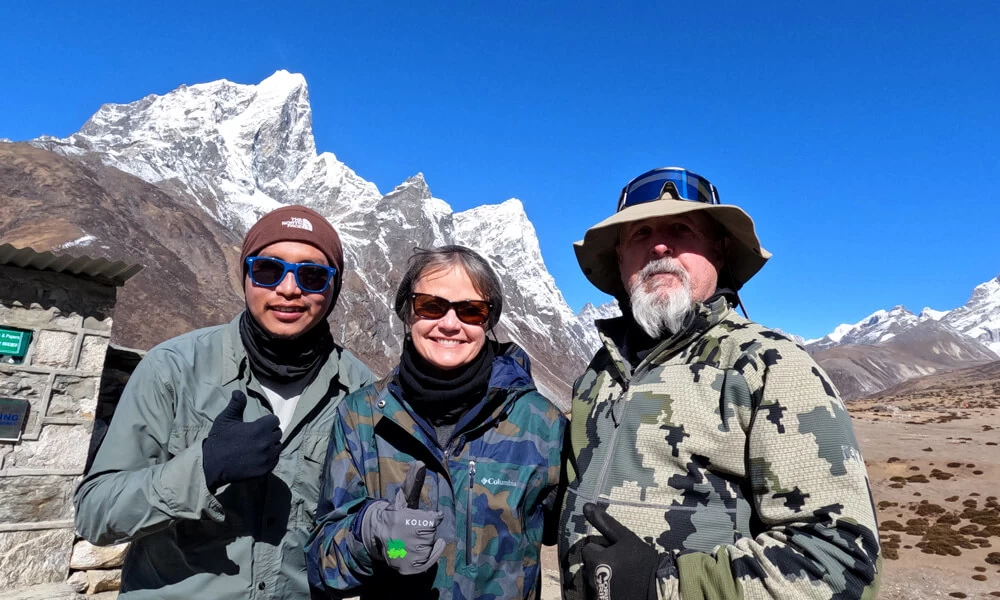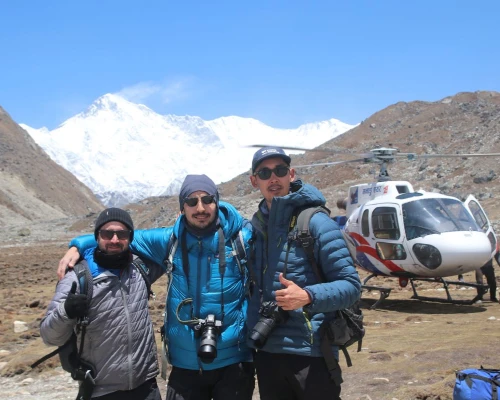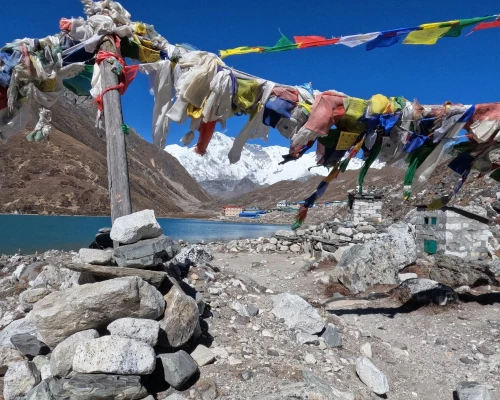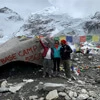Introduction to Everest Base Camp via Gokyo Lake and return with a Helicopter Return
The Everest Base Camp via Gokyo Lake with Helicopter Return is the ultimate circuit, blending raw adventure with scenic solitude. The helicopter exit saves your legs and doubles the views. You walk through peaceful valleys, witness the pristine Gokyo lakes, conquer the icy Cho La Pass, and reach Base Camp before flying back like a boss. However, this is just not an ordinary EBC trek.
This trek is suitable for people who are looking for more than the regular Everest route. Whether you are trekking solo, with friends, or in a small group, this route is ideal if you are after quiet trails, panoramic views, and a luxury heli exit that saves your knees (and your time).
Unlike the classic Everest Base Camp trek, this route adds a loop through Gokyo Valley, making it more remote, varied, and visually epic. You get all the Himalayan drama: glaciers, lakes, and 8,000-meter gains without the crowd rush.
The entire journey takes 13 to 15 days, depending on how many acclimatization stops you make. The helicopter return usually happens from Gorak Shep or Pheriche, giving you 30-40 minutes of unreal aerial views all the way back to Lukla or even Kathmandu.
Emotionally? This route hits different. It’s quiet, powerful, and deeply memorable.
You will witness turquoise lakes, frozen rivers, and sunrise over Everest, with far fewer people around you. It’s a once-in-a-lifetime trek that balances rugged adventure with just the right amount of comfort.
The standard itinerary flows from Lukla to Gokyo, then crosses Cho La Pass, reaches Everest Base Camp and Kala Patthar, and ends with the helicopter return. It’s a full circuit; no backtracking, and it gives you everything the Everest region has to offer in one seamless journey. Perfectly crafted for trekkers who want the ultimate Everest Base Camp Best Itinerary experience.
Difficulty level and its preparations for the Everest Base Camp via Gokyo Lake with a Helicopter return
This route is rated moderate to challenging, definitely doable, but it's not a casual stroll. The trails are well-marked and safe, but it’s not a casual stroll. The high altitude and Cho La Pass (5,420m) require solid fitness. The pass can get icy and steep, especially in colder seasons, so you will want to feel confident walking over snow or rock in microspikes.
If you have done a high-altitude trek before, this is your next-level adventure. If not, do not worry! With some basic training, good gear, and mental preparation, most fit hikers can handle it. It helps if you’ve been active with cardio, hill walks, or even gym training before flying out.
Want to crush this trek with zero drama?
Start preparing with cardio workouts and elevation gain practice hikes at least a month or two in advance. Building up endurance and leg strength is key. Bonus points if you train with a backpack. While you are at it, make sure your gear game is strong, especially trekking boots, poles, and layers for high passes. And don't forget to study weather windows. Spring and autumn are ideal; dry, clear, and stable. Following these tips on how to avoid altitude sickness during Everest Base Camp trekking will help you stay healthy and make the most of this epic adventure.
Difficulty Level
This is a moderately challenging trek that demands heart and hustle. The altitude can get real (like, over 5,000m real ), and the terrain throws in everything from rocky trails to icy mountain passes. The big boss of the trail? Cho La pass; it's steep and can be slippery with ice.
But honestly, anyone in good shape with a bit of mental toughness can do it. You don't need to be a pro mountaineer, just someone who enjoys a challenge and has some trekking experience or solid fitness.
Its preparation
Getting ready for this trek? Let’s be real, it’s not exactly a Sunday stroll. This route is moderate to challenging, especially when you are climbing high-altitude passes like Cho La, which can get icy and tricky depending on the season. Understanding the fitness level required for Everest Base Camp is crucial, as a solid level of fitness is non-negotiable.
It’s not suited for people who already have some trekking experience or at least are in good physical health and up for an adventure. But don't worry, with the right preparation, you’ve got this!
Training tips that actually help:
- Cho La Pass can be icy – requires fitness.
- Suitable for trekkers with some experience or good health
- Training tips: cardio, strength, altitude prep
- How trekking poles, boots, and gear help
- Weather impacts & best times to go (pre-monsoon/post-monsoon)
Trek Cost Breakdown
Let’s be real- the cost of the Everest Trek can depend on the way you choose the trek. Are you a solo backpacker doing it raw? Hiring a local guide? Or maybe booking through a full-on agency with everything handled for you? The difference in cost is pretty major. Solo trekkers might spend as low as $700-$1000(bare minimum), while guided treks can run around $1200-$2000, and luxury packages? Yeah, you’re looking at $3000+ easy.
Now here’s a clever hack: if you want to see a full breakdown comparing solo, guided, and luxury treks, we actually created a detailed guide that does all the math for you.
What’s Included(and What’s Not)
Let’s break it down like a pro: the base cost of your trek will include food, accommodation (hello, tea houses), trekking permits(TIMS & Sagarmatha), and sometimes gear rental if you’re not carrying your own. But you don’t sleep on those sneaky hidden costs: WiFi in the mountains can cost up to $5-10/day, charging your phone or camera? Add another few bucks per change. And yes, tipping your porter or guide is a thing, usually around 10 percent of the trip, depending on how generous you’re feeling.
Thinking about a fast way down? Many trekkers opt for a helicopter return from Gorak Shep or Pheriche to Lukla or even Kathmandu. That’s a whole separate cost- usually $300-$600 per person(depending on seat availability). It’s a splurge, but it saves you 3-4days of hiking, and honestly, the views are worth every penny.
Budget to Boujee: Which Package is Your Vibe?
Whether you’re a shoestring traveler or you want to flex a little, there’s a trek package for you. Budget treks (think DIY or with a local guide only) can keep your Everest dream alive under $1000 if you’re careful. Mid-range guided treks(with proper meals, porters, and safety support) cost around $1500-$2000. And if you’re here to do it big- think heated rooms, gourmet food, and helicopter exits- then luxury treks can hit up to $4000 or more.
Everyone’s budget is different, so plan accordingly- but don’t forget to factor in gear rental, flights to Lukla, and those unseen extras that sneak up fast. Again, if you want the full cost breakdown side-by-side(with numbers that make sense), head over to our Everest Trek Cost guide and get the full tea.
Local Festival
Local festivals are an important part of every community. They bring people together to celebrate their culture, beliefs, and way of life. These (what next)
Dumje
Dumje is a lively and meaningful festival celebrated mostly by the Sherpa people living in Nepal's mountains. It usually happens in the fall, around October or November, depending on the lunar calendar. The highlight of Dumje is the masked dances performed by monks wearing colorful traditional costumes. The prayers and meditation are meant to chase away evil spirits and bring peace and good fortune to everyone.
Besides the dances, the festivals are also about coming together to share traditional Sherpa food in big communal meals, which helps build strong community bonds. For the Sherpas, Dumje isn't just a festival; it's an important part of their culture and spiritual life, showing their deep respect for nature and the world around them.
Mani Rimdu
Mani Rimdu is another highly significant festival celebrated mainly by the Sherpa and Tibetan Buddhist communities in the Everest region of Nepal. It usually takes place between October and November and lasts for several days, making it one of the most eagerly awaited festivals of the year. It honors Guru Rinpoche, the saint who brought Buddhism to Tibet back in the 8th century.
During the festival, monks perform colorful masked dances called "cham" that tell stories of good triumphing over evil and the path to enlightenment. These dances are accompanied by traditional music with drums and cymbals, creating a powerful and moving atmosphere. Mani Rimdu attracts tourists worldwide with both religious observance and a vibrant cultural show, who are eager to experience the rich heritage of the Himalayan Buddhists.
Why choose the Everest Base via Gokyo Lake with a Camp with a Helicopter return?
Choosing the Everest Base Camp (EBC) trek via Gokyo Lake offers a breathtaking alternative to the classic EBC route, providing far more scenic variety. Unlike the usual trek that sticks mostly to the Dudh Koshi River valley, the Gokyo route treats you to stunning turquoise lakes, incredible mountain views, and a much quieter trail, perfect if you want to escape the crowds and really connect with nature.
Along the way, you will tackle the challenging Cho LA pass, which pushes your limits but rewards you with some of the best panoramic views of the Himalayas. And if time or the physical challenge worries you, you can always take a helicopter back from Everest Base Camp, cutting down the trek and giving your body a well-deserved break while still enjoying an unforgettable adventure.
Compared to the tougher three-pass trek, which involves longer days and multiple high passes, the Gokyo plus Everest Base Camp route with a helicopter return offers a great balance of challenges, breathtaking scenery, and convenience, making it an ideal choice for travellers who want the best of Everest without pushing themselves to the limit.
Gokyo Lake and Gokyo Ri
Gokyo Lake and Gokyo Ri are the main events of the Everest Base Camp trek via Gokyo, offering some of the most epic and Instagram-worthy views in the entire Himalayas. Sitting at an elevation of around 5357 meters(17575 feet), Gokyo Ri is a popular sunrise viewpoint that rewards trekkers with an unreal 360-degree panorama of four towering 8000ers: Mount Everest (8848m), Lhotse (8516m), Makalu(8485m), and Cho Oyu (8188m).
You’ll also see the majestic Ngozumpa Glacier- the longest glacier in the Himalayas- sprawling below like a frozen river from another world. Most trekkers wake up before dawn, usually around 4 am, to begin the climb up Gokyo Ri. Why so early? Because catching the first rays of sunlight hitting Everest and lighting up the snow-capped peaks is pure magic- and it’s something you’ll never forget. It’s moments like these that make Gokyo Ri such a bucket-list-worthy spot on this route.
Cho La Pass
Cho La Pass is one of the most thrilling and scenic high passes on the Everest Base Camp route via Gokyo Lake, located at an altitude of approximately 5,420 meters (17,782 feet). This icy, rugged mountain pass connects the peaceful Gokyo Valley with the bustling Khumbu Valley and is a true adventure for those who crave something more offbeat and dramatic.
Crossing Cho La rewards you with incredible views of towering peaks like Cholatse (6,440m), Taboche (6,501m), and, in the distance, the stunning Ama Dablam (6,812m), one of the most beautiful mountains in the Himalayas. The trail takes you over a small glacier, jagged rocks, and snowy paths, all adding to the rugged, alpine charm of the journey. Surrounded by towering ice walls and a vast white landscape, Cho La feels like stepping into a wild, remote world that's truly unforgettable.
Everest Base Camp and Kala Patthar
Reaching Everest Base Camp at a distance of 5364 meters (17598 feet) is the dream moment for trekkers worldwide, but here’s the real tea: while standing at EBC is emotional and iconic, the actual best views of Mount Everest come from nearby Kala Patthar, which stands even higher at 5545 meters(18192 feet). At EBC, you’re right at the foot of the Khumbu Icefall, surrounded by towering seracs and colorful prayer flags, with views of **Nuptse(7861m)**, Pumori(7161m), and the looming Khumbu Glacier. You won’t see the Everest summit clearly from base camp itself, but that’s where Kala Patthar steps in.
Trekkers usually hike up to Kala Patthar before sunrise, braving the cold and altitude to catch that magical golden hour view of Mount Everest (8848m) glowing in the first light. And trust it’s 100% worth the early wake-up call. From the top, you get the most iconic close-up views of Everest’s peak, along with Lhotse, Nuptse, Ama Dablam, and even glimpses of Makalu on a clear day. It’s raw, breathtaking, and the kind of experience that leaves you totally speechless (and probably crying happy tears). No wonder it’s considered one of the best viewpoints in the entire Khumbu region, and a must for any serious trekking bucket list.

.webp)
.webp)

.webp)
.webp)
.webp)
.webp)
.webp)

.webp)
.webp)
.webp)
.webp)



.webp)
.webp)